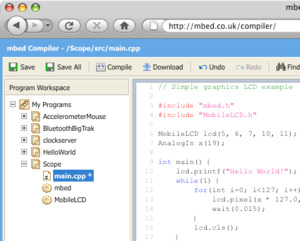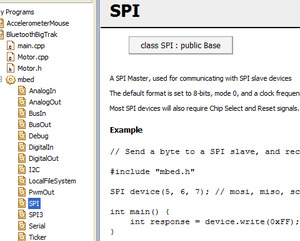
POLOLU
ARM mbed NXP LPC1768 Development Board
Description
The mbed NXP LPC1768 development board from ARM enables quick and easy creation of high-performance prototypes. Based on the powerful NXP LPC1768 Cortex-M3 processor, which runs at 96 MHz and offers 512 KB flash and 32 KB SRAM, the 32-bit mbed can handily outperform popular 8-bit prototyping platforms like the Arduino and Basic Stamp. The mbed NXP LPC1768 also offers peripherals not typically found on lower-performance prototyping boards, such as ethernet, USB OTG, a 12-bit ADC, a 10-bit DAC for a true analog voltage output, in addition to more common interfaces like serial (UART), SPI, I2C, and CAN. The mbed has a 40-pin DIP form factor with 0.1"-pitch male header pins already soldered in, so it can be used with standard solderless breadboards and perfboards. (Note that while standard DIP ICs have a row spacing of 0.6", the mbed rows have a spacing of 0.9".)
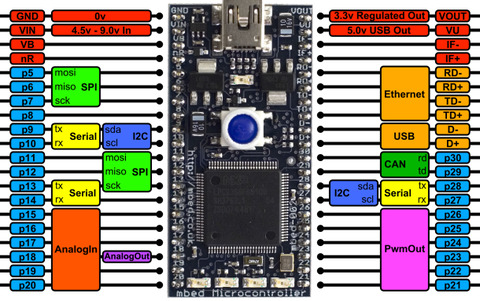 |
| ARM mbed NXP LPC1768 development board peripherals and pinout. |
|---|
For applications requiring low cost or low power consumption, consider the mbed NXP LPC11U24 as an alternative development board. Our comparison table can help you choose the right mbed for your application.
One of the strengths of this platform is the mbed Library, which provides an API-driven approach to coding that eliminates much of the low-level work normally associated with MCU code development. Code can be developed using meaningful peripheral abstractions and API calls that are intuitive and well tested, freeing you up to experiment without worrying about the implementation of the MCU core or its peripherals.
Another key feature of the mbed is its unique C++ compiler and IDE. These free tools are entirely web-based and run online, which means there is no software to download or install. Supported browsers include Internet Explorer, Firefox, Safari, or Chrome running on a Windows, Mac, or Linux PC. You can log in from anywhere and simply pick up where you left off, and this approach makes it very easy to share code with others. And, since you’re working with a web-based tool, you can be confident that it is already configured and will stay up-to-date. The compiler uses the ARM RealView compile engine, so it produces clean, efficient, optimized code that can be used free-of-charge, even in production. Existing ARM application code and middleware can be ported to the LPC1768 microcontroller, and the mbed tools can be used alongside other professional production-level tools, such as Keil MDK.
|
|
No external programmer is required to program the mbed. When connected to your computer via the included USB cable, it shows up as a mass storage device. Simply save the compiled binary file to the board to program it.
Features
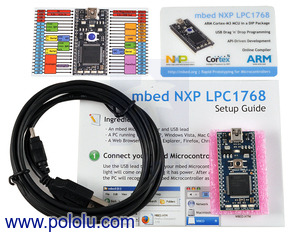  |
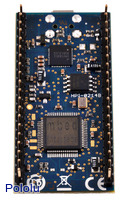  |
- Can be powered by USB or an external 4.5 – 9 V supply (supply voltages up to 12V should generally be safe, but at these voltages the regulator may start to overheat if used to power external components)
- Compact module: 54 mm × 26 mm
- Convenient form-factor: 40-pin DIP (0.9" row spacing), 0.1" pitch
- Drag-and-drop programming, with the board represented as a USB drive
- Best-in-class Cortex-M3 hardware
- 96 MHz ARM with 32 KB of SRAM, 512 KB of Flash
- Ethernet, USB OTG
- SPI, I2C, UART, CAN
- GPIO, PWM, ADC, DAC, DMA
- Easy-to-use, free online tools
- Web-based C/C++ programming environment
- Uses the ARM RealView compile engine
- API-driven development using libraries with intuitive interfaces
- Comprehensive help and online community
- On-board LEDs can be used for feedback, and a serial port over the USB connection allows for printf-style debugging
Getting Started
Getting started is as simple as using a USB Flash drive. Simply connect the mbed NXP LPC1768 board to a Windows, Mac, or Linux computer and it will automatically appear as a USB drive. Follow the link on the board to connect to the mbed website, where you can sign up and begin designing. There are no drivers to install or setup programs to run. Getting started is so easy that you can have a “Hello World!” program running in as little as five minutes.
The mbed development board includes the necessary USB A to mini-B cable, a printed quickstart guide, and two business cards that contain a life-size pinout diagram for the mbed.
The following videos show just how easy it is to get started using the mbed:



